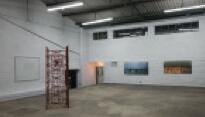Desde mañana
LIA Laboratorio Interdisciplinario para las Artes, Bogota
Far removed from the discourse of a curated show on a particular theme, this exhibition gathers together some of the best names in what critics have termed The Intermediate Generation, known as a “hypothetic generation which includes, in fact, several generations and which is situated between the New Names and the Great Masters, a heterogeneous group of artists of very different ages and with very different trajectories, who have developed a consistent and serious body of work,” in the words of Darío Jaramillo, who was the Assistant Manager for Cultural Projects at the Bank of the Republic in the 1990s.

Visitors to this show may appreciate the way in which, not far removed from this description, the works of five artists hold a dialogue just like they did in those days: absorbed in their own discourse, each of these artists narrates his or her own reality, which confronts the reality of the others, in absolute mutism. Rosario López, the winner of 7th Bogotá Art Biennial, participates with a work belonging to her series Lo informe y el límite, which pretends to explore the work potential that can be found in the landscape, where there is room for both the organic and the malleable built with noble materials that generate a new visual imaginary complying with the concept of landscape.
Rodrigo Facundo employs photography to show us his particular relationship with time; thus, in his series Phantographies he proposes the coexistence of past, present, and future in the present, the only place where events interconnect and a fabric capable of generating a discourse is created. For her part, Catalina Mejía, the winner of the 34th National Artists’ Salon (1992) continues to feature allusions to identity through her past: blurred images of the spines of books in bookcases showing empty spaces suggest a direct relationship with memory.
With her installation Celosías, estéticas de la paranoia, Luz Ángela Lizarazo invites the viewer to see what it means to live behind a grille, an element drawn from the popular imagery in the streets of Bogotá, which only reflects the paranoia that its inhabitants experience, an ornamented fear, “fear that is narrated though aesthetics.” Lastly, Delcy Morelos continues the development of the relationship established between the body, color and emotions, which has informed her whole artistic production.





